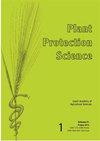巴基斯坦棉属植物叶斑病的新威胁
IF 1.4
4区 农林科学
Q2 AGRONOMY
引用次数: 3
摘要
棉花在世界各地都有种植,包括亚洲国家。在巴基斯坦旁遮普省棉花区不同地区的棉花上观察到严重的叶面病症状。从不同地区取样受感染的植物叶片,并处理以分离致病生物。真菌分离株进行形态鉴定。真菌的分生孢子呈长圆形至椭球状,透明,无孢子,偶尔有1-间隔,尺寸为2.7 ~ 7.8 × 1.6 ~ 3.5 μm。对2个分离株进行了进一步的遗传多样性鉴定。两株菌株对E代谢物的NaOH试验均有中等反应。病原菌形态鉴定为布尔米菌。进一步对真菌分离物的内部转录间隔区(ITS)和TUB基因进行扩增和分析。部分ITS和TUB序列与该菌株同源性达99%。用2株小夜蛾对3月龄棉花进行了致病性试验。接种15天后,叶片上开始出现坏死斑,与田间观察到的坏死斑非常相似。从所有接种植株的叶片中重新分离出真菌病原体,根据科赫的假设进行形态学鉴定。这种疾病可能是巴基斯坦未来棉花生产的潜在威胁。然而,需要进一步的研究来了解病原体的毒力、行为、交替宿主和传播性质。本文章由计算机程序翻译,如有差异,请以英文原文为准。
Boeremia Exigua Leaf Spot: A New Emerging Threat to Gossypium hirsutum L. in Pakistan
Cotton is grown all over the world including Asian countries. Severe foliar disease symptoms were observed on cotton in fields from different districts of cotton zone of the province of Punjab, Pakistan. Infected plant leaves were sampled from various areas and processed for the isolation of the causal organism. Fungal isolates were identified morphologically. The conidia of the fungus were observed oblong to ellipsoid, hyaline, and aseptate, but occasionally 1-septate with dimensions ranging from 2.7 to 7.8 × 1.6 to 3.5 μm. A total of two isolates were characterized further for genetic diversity. Both the isolates showed moderate reactions to the NaOH test for E metabolite. The pathogen was morphologically identified as Boeremia exigua. Further, the internal transcribed spacer region (ITS) and TUB gene of the fungal isolates were amplified and analyzed. The sequence of partial ITS and TUB showed 99% homology with the isolates of B. exigua. The pathogenicity test was performed on three months old cotton plants by using two isolates of B. exigua. After 15 days of inoculation, necrotic spots started developing on the leaves that were very similar to those observed in the field. The fungal pathogen was re-isolated from the leaves of all the inoculated plants, identified morphologically following Koch's postulates. This disease might be a potential threat to cotton production in Pakistan in the future. However, further studies are required to know the virulence, behavior, alternate hosts, and spreading nature of the pathogen.
求助全文
通过发布文献求助,成功后即可免费获取论文全文。
去求助
来源期刊

Plant protection science
Agronomy-PLANT SCIENCES
CiteScore
2.90
自引率
7.70%
发文量
30
审稿时长
12 weeks
期刊介绍:
Original papers, short communications, critical reviews, personal news, and book reviews covering all areas of diseases and pests of plants, weeds and plant protection. Papers are published in English.
 求助内容:
求助内容: 应助结果提醒方式:
应助结果提醒方式:


